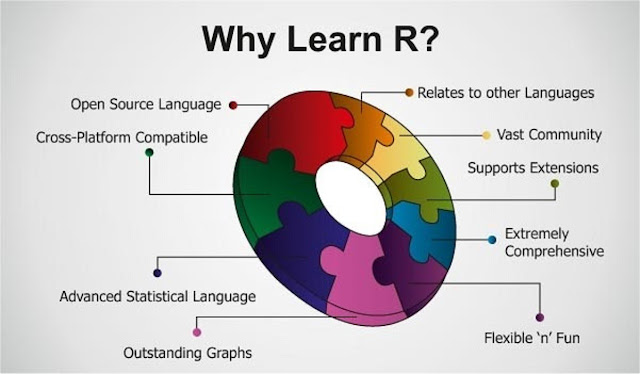Data
science with R
Data science is an exciting discipline that allows
you to transform raw data into understanding, vision and knowledge. The goal of
"R for science of science" is to help you learn the most important
tools in R that will allow you to do data science. After reading this blogs,
you will have the tools to tackle a wide variety of data science challenges,
using the best parts of R.
R is a programming language used widely for data
analysis and statistical computing. R is an interface for the user. Send us to
the communities of data networks around the world. We also have a large number
of Internet users. Packages like dplyr, tidyr, reader, data, table, SparkR and
ggplot2 tornaram to dice manipulation, visualization and computation are much fast.
What Is R Today? It’s Many
Things:
•
R
is a data analysis software: data scientists, statisticians
and analysts - anyone who needs to understand the data, can actually use the R
for statistical analysis, data visualization and predictive modeling
•
R
is a programming language: R is an environment for
statistical is an open source software program: R is free and, thanks to years
of analysis and adjustment.
•
R
is a open source software program: R is free and, thanks
to years of analysis and adjustments by users and developers, has a high
standard of quality and numerical accuracy.
•
R
is a community: Project R's leadership grew to include
more than 20 computer scientists and scientists from around the world, and
thousands of contributors created additional packages. With two million users,
R has a vibrant online community.
Data
Science Applications In R
The first call back into mind now for days whenever
someone rings a data word the next few words come to R as a supporting
language. R is organized in many ways, but we will see in what structure we
will proceed.
•
Gather the required data
•
Load the data in R. (Import data to R)
•
data deduction / data reduction / data
cleaning
•
Exploratory analysis of data
•
Building models based on demand
•
Applying Machine Learning Algorithms
•
Bringing perceptions of the data
•
Optimizing the data
Once we do all the previous steps, the
visualizations highlight what R always defines. Most business decisions can be
resolved with views. We apply the R programming language and statistical
analysis techniques to explain marketing, business intelligence and decision
support for the company.
Essentials Of R
Programming
This is the block of the construction of the
programming system R. the voice is facing the debugging problems. A vector,
matrix, square of dice, time of measure, object
R basic
classes of objects is included:
•
1.character
•
2. Numeric (real numbers)
•
3. Integer
•
4. Complex
•
5. Logical
As the classes are self-explanatory, they are not
self-explanatory. classes have attributes. Think of us as attributes such as
"identifier", a name or number that identifies you properly.


Comments
Post a Comment